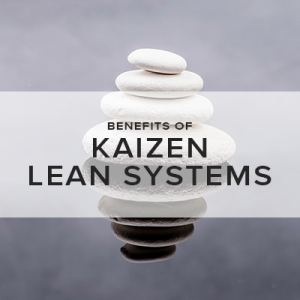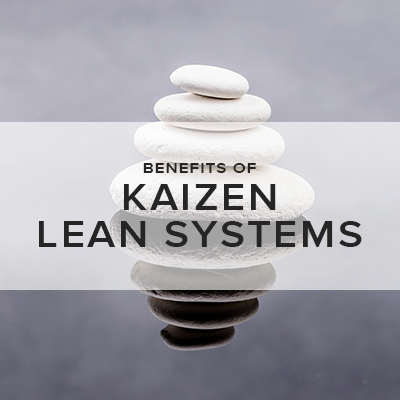Kaizen Lean Systems
 A lean system, like Kaizen, is a method that focuses on business efficiency. The goal of any lean system is to eliminate or reduce waste in a process, which is also sometimes referred to as muda. Muda can be defined as any process in an operation that are non-essential or does not contribute to the overall value of a product or service (Russell & Taylor, 2017). The concept of reducing waste is like spring cleaning because the goal is to get rid of items or processes that create clutter and reduce efficiency. Reducing the number of steps in a process can help to accelerate how quickly a process can be performed. Having less processes could also reduce maintenance fees and possible downtime. For example, a widget company may find that by moving their shipping area closer to their warehouse can reduce the time it takes to pick an item from the warehouse to shipping it to a customer. By eliminating the waste of extra movement in this example saves time, money, and could make customers happier to receive their products quicker.
A lean system, like Kaizen, is a method that focuses on business efficiency. The goal of any lean system is to eliminate or reduce waste in a process, which is also sometimes referred to as muda. Muda can be defined as any process in an operation that are non-essential or does not contribute to the overall value of a product or service (Russell & Taylor, 2017). The concept of reducing waste is like spring cleaning because the goal is to get rid of items or processes that create clutter and reduce efficiency. Reducing the number of steps in a process can help to accelerate how quickly a process can be performed. Having less processes could also reduce maintenance fees and possible downtime. For example, a widget company may find that by moving their shipping area closer to their warehouse can reduce the time it takes to pick an item from the warehouse to shipping it to a customer. By eliminating the waste of extra movement in this example saves time, money, and could make customers happier to receive their products quicker.
What is Kaizen?
Kaizen is a type of lean system that focuses on making gradual changes to improve any process through Kaizen events (Lean Production, 2019). Making small incremental changes is beneficial in that it does not require major changes to operations. Big changes can be disruptive to some businesses, while incremental changes are easier to manage and observe the effects. Big changes in processes can also sometimes cause unexpected issues that were not possible to foresee ahead of time. Making a smaller change and observing if it made a process better or worse could be more practical, because it’s likely the process could be switched back to how it was prior to the change. Kaizen also has a philosophical aspect in that it also recommends instilling a culture where all employees are engaged in pointing out areas for improvement, as well as, acting on changes to improve (Lean Production, 2019). This means that employees at all the levels of the company are involved in Kaizen. A good idea for improvement can come from any level of an organization from the executives to the janitor of a company. People generally like to hear that their voice is being heard. By giving people an opportunity to make suggestions gives every person in an organization a chance to point out areas for improvement instead of directions always coming from upper management.
Kaizen requires all levels of the organization to be on-board with seeking opportunities to improve, with an eventual goal of inculcating a culture and philosophy of continuous improvement. Former President John F. Kennedy once said, “one person can make a difference, and everyone should try” (Culture of Life Studies Program, n.d.). In some ways the words of the former United States President mirrored a similar ideology of Kaizen where everyone strives to make a positive difference. In another way the ideology empowers individuals and encourages everyone to contribute. Some people might be able to make a greater effort and contribute more, while other people might not be able to contribute as much. If everyone contributes, no matter how big or small the effort, the idea is that optimal efforts can be achieved. The principals of Kaizen instill the concept of every person doing their best to contribute to the success of the whole.
Utilizing Kaizen aims to improve quality by realizing the source of quality issues. One of the key elements of Kaizen is identifying the underlying causes of a problem with a goal to eliminate the probability of an issue occurring in the first place (Russel & Taylor, 2017). Identifying the root cause of an issue can help an organization to determine deeper issues in a process to discover what changes will produce the greatest results. The Kaizen approach seeks to find a long-term solution rather than just fixing the symptoms of a problem. One Kaizen technique involves asking “why?” at least five times to learn the real reason of a problem until the actual cause of the problem is revealed (Russel & Taylor, 2017). By asking why something has happened repeatedly, causes the team to focus on an issue and the origins of that problem. For example, a team might seek out the reason why the Washington Monument is deteriorating. By asking why repeatedly it may be discovered that the real reason for the monument deteriorating is not the chemicals used to clean bird droppings, but it’s because the birds eat the spiders, the spiders eat the gnats, and the gnats are attracted to the lights around the monument at dusk (Russel & Taylor, 2017). Initially, it may have been thought that the chemicals to clean the monument needed to be changed by only asking why once. Changing the cleaning chemicals might have solved one problem, but the bird droppings would still need to be cleaned. By asking why repeatedly, it was discovered that the bird droppings and spiders could both be eliminated by turning the monument lights on a half an hour after dusk (Russel & Taylor, 2017). Thus, this adjustment could stop the gnat problem and eliminate the issue at its source. In this case making one change to the light schedule also helped to solve several other issues as well. Finding the root cause of the issue by asking why repeatedly allowed the team to determine the real reason why the monument had to be cleaned very frequently, which caused deterioration of the monument.
Conducting a Blitz
Sometimes an issue may need more immediate attention, which Kaizen offers another method for more quickly solving an issue. This other method of Kaizen improvement involves conducting a Kaizen blitz. A Kaizen blitz requires several days of intense focus on improving a process with the goal to create real-time results and align employee conduct (Russel & Taylor, 2017). At these Kaizen events or blitzes, there are typically several steps that are followed. The Kaizen event steps include setting a goal with accurate background information, reviewing the current state of a process, developing an improvement plan, implementing improvements, reviewing what did and did not work, reporting on results, and determine if anything will require additional follow up (Lean Production, 2019). These Kaizen steps mirror Dr. Deming’s PDCA wheel of plan, do, check and act. The goal of each Kaizen event or activity is to reduce waste. Waste in a business or personal process causes inefficiencies. Waste can also take many forms, such as, excess movements, too much idle time, defects, over processing, and variations in production. Although Kaizen was originally developed to create high quality products at lower costs in Japanese manufacturing companies, it can also be used in all types of businesses and personal life too. For example, variations in a business process can be reduced by creating standardized templates that could be repurposed for similar or various uses. In this example, having a standardized process eliminates the need to create a new form every time a form might be needed, which saves a company time and money. By implementing Kaizen, a business decreases waste by right sizing production, increasing quality, becoming more efficient, and removing any activities that do not add value. All these Kaizen activities help businesses to save money in the production process and convert potential losses in processes into profits.
References
Culture of Life Studies Program (n.d.) John F. Kennedy. Retrieved from https://cultureoflifestudies.com/resources/one-person-can-make-a-difference-and-everyoneshould-try-president-john-f-kennedy/
Lean Production (2019). Kaizen. Retrieved from https://www.leanproduction.com/kaizen.html
Russel, R. & Taylor B. (2017). Operations and supply chain (9th ed.). Danvers, MA: John Wiley & Sons, Inc. Retrieved from https://purdueuniversityglobal.vitalsource.com/#/books/9781119320975/cfi/6/18!/4/2/2/2/2@0:0


